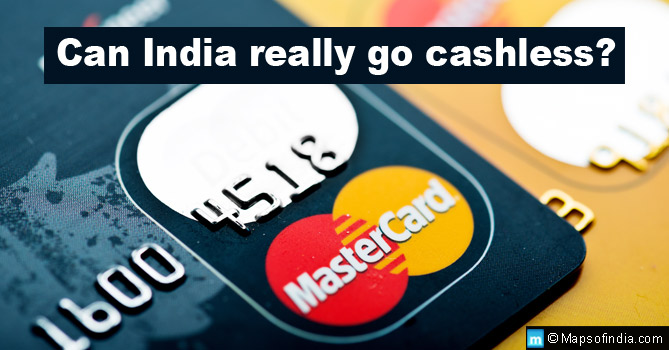Ever since the Indian Government has opted to take back notes of Rs. 500 and Rs. 1000 the number of people waiting outside banks and ATMs has only increased. A lot of people are still looking to get their old banknotes exchanged, get money for their daily expenses, and in such a situation it seems that plastic money – in the shape of credit cards and debit cards – could be the only way forward. However, one question that needs to be asked in such a situation is: Is it really possible for India to become a cashless society per se?
The question of being ready
It needs to be asked if people in India are ready for such a system in the first place before implementing the same. As far as statistics go, the situation does not look to be so good. As per data released by Reserve Bank of India (RBI) during July 2016, the apex banking organization of India has provided 697.2 million debit cards and 25.9 million credit cards till the end of July this year. These net figures have been adjusted taking into account cards that have either been withdrawn or cancelled.
Is the number of cards enough?
The authorities need to make sure that if the total amount of cards is good enough for India to become a cashless country and transact without any problem whatsoever. There are three ways in which cards are used. You can make online payments with them or take out cash from ATMs. Last, but not the least, you can swipe them at point of sale (POS) terminals in various merchant establishments. So far, demonetization has had no effect on the e-commerce sector except in areas where people are still paying in cash upon delivery.
Domination of cash transactions
India is one country where most of the transactions take place in cash. If such a huge amount of transaction has to be changed to the online format, then POS terminals in the same number would be required across the country. Apart from that, it also needs to be taken into consideration that the number of cards in India does not give a proper reflection of things. Most people – especially in the urban areas – have more than one card.
How many POS terminals are there in India now?
An RBI data states that there are around 1.44 million POS terminals across the country that banks have installed. However, this figure is meant for July end. Apart from that, there are at least two lakh ATMs in India. We need to ask if this figure is good enough for India to be transacting without any cash whatsoever. Let’s look at some statistics to get a clear picture. In Uttar Pradesh only, there are around 150,000-200,000 counters for recharging telecom services. This figure only shows the telecom retailers and does not reflect other smaller establishments that may be doing a similar job. So, can anyone over there use anything other than cash? At the present rate, will the number of POS terminals be sufficient – perhaps not.
The RBI data does not say anything about POS terminals in the rural parts. One feels that these terminals are presently in urban, and semi-urban areas at best. Among the banks with POS terminals, five – SBI, ICICI Bank, Axis Bank, Corporation Bank, and HDFC Bank – together have 1.16 million terminals. Apart from SBI, the rest operate mainly in the urban areas.
Why are debit cards used?
In July 2016, there were 881 million instances where debit cards were used at POS terminals and ATMs. In 85% of the cases, the aim was to withdraw cash from the ATMs. As far as value goes, the said percentage goes up to 92. This indicates that debit cards are not used to buy goods and services but only to take out money from the ATMs.
What are the major challenges?
In case of POS terminals, mobile internet is used to make transactions happen. However, the rate of mobile internet penetration in India remains weak, especially in rural India. These transactions are also costlier since the banks levy some fee for each transaction. This, alongwith poor rates of awareness and information among rural and semi-urban people in India make it rather hard to promote the usage of plastic money.
Should India take the plunge?
Cash is something that will always be favoured and this is the reason why people like it so much. Cash is something that will work even in the farthest parts of the country, where other state infrastructure may be absent. Cash is basically the writ of the government. Our informal economy, which comprises the bigger slice and is also a reason for the present situation, runs on cash. Considering the difficulties that may arise and the problems – more cases of parallel economy and problems in the unorganized rural sectors – that may be caused, the Indian Government would do well to think deep before it decides to go cashless completely.
However, promoting and facilitating its usage are something that should be done so that one day baseline corruption and black money are truly and completely routed out.
Also Read:
- Tourist Season Faces Brunt Of Demonetisation
- Paytm, Mobikwik, Freecharge: eWallet Reviews and Comparison
- SBI Writes-Off Defaulters’ Loans from Balance Sheet
- How Will Rs 500, Rs 1000 Note Ban Impact Real Estate?
- Why is Rs 500 Note Banned in India?
- Rubbing salt worth Rs 400/kg into people’s wounds?
- Note Ban Juggernaut May Hit Poll Campaigns in UP, Punjab
- What’s Unique About The New Rs 500, Rs 2000 Notes?
- E-commerce boom and hurdles in India






